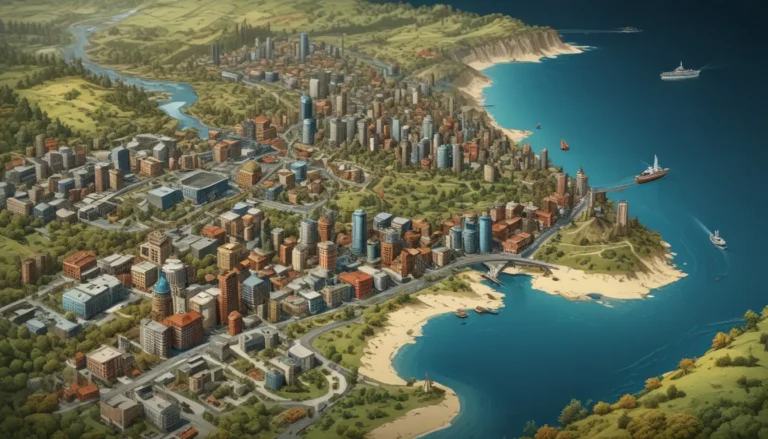A Note About Images: The images used in our articles are for illustration purposes only and may not exactly match the content. They are meant to engage readers, but the text should be relied upon for accurate information.
As urbanization continues to shape the world around us, the phenomenon of urban heat islands emerges as a captivating subject of study. These areas within cities exhibit significantly higher temperatures compared to their rural surroundings, creating pockets of intense heat known as urban heat islands. The interplay of various factors such as building materials, lack of vegetation, and human activities contributes to the formation of these heat islands.
In this enlightening article, we delve into 19 intriguing facts about urban heat islands, unraveling their causes, effects, and potential mitigation strategies. Join us on this journey as we explore the hidden layers of urban heat islands and discover ways to create cooler, healthier, and more sustainable urban environments.
Key Takeaways:
- Urban heat islands are regions within cities that experience much higher temperatures than their rural counterparts, with temperature differentials reaching up to 22°F (12°C) during hot summer days.
- Green spaces, reflective materials, and urban planning techniques play key roles in reducing the urban heat island effect, fostering cooler, healthier, and more sustainable urban landscapes.
Understanding Urban Heat Islands
An urban heat island signifies the elevated temperatures observed in urban areas compared to surrounding rural regions. Human activities and urban landscape characteristics primarily drive the formation of urban heat islands.
The Impacts of Urban Heat Islands
Urban heat islands influence both air and surface temperatures, affecting not only the ambient air but also the temperature of buildings, roads, and pavements. In highly populated cities, temperature disparities of up to 22°F (12°C) can be observed between urban and rural areas during hot summer days.
Factors Influencing Urban Heat Islands
The size and density of urban areas significantly impact the extent and intensity of urban heat islands, with larger cities exhibiting more pronounced heat islands. Materials such as concrete and asphalt, which absorb and retain heat, contribute to higher temperatures in urban environments.
Effects on Human Health and Environment
Urban heat islands can lead to increased energy consumption for cooling buildings, resulting in elevated greenhouse gas emissions. Moreover, the intense heat in urban areas can adversely affect human health, triggering heat-related illnesses, elevated stress levels, and diminished air quality.
Mitigation Strategies
Implementing urban planning techniques like green roofs, urban forestry, and sustainable building designs can help mitigate the urban heat island effect and foster more sustainable cities. Reflective materials such as cool roofs and pavements can aid in reducing heat absorption and lowering temperatures.
Driving Forces Behind Urban Heat Islands
Weather conditions such as wind direction and cloud cover can influence the intensity and persistence of the urban heat island effect, exacerbating temperature differentials within cities.
Encouraging Change at the Individual Level
Individuals can make a meaningful impact in reducing urban heat islands by planting trees, utilizing light-colored or reflective surfaces, and adopting energy-efficient practices in their homes and communities.
Conclusion: A Path Towards Sustainable Cities
Urban heat islands present both challenges and opportunities for urban environments. By embracing innovative solutions and urban planning techniques, we can mitigate the negative impacts of heat islands and create cooler, more sustainable cities for all.
FAQs: Unraveling Common Inquiries
-
What causes urban heat islands?
Urban heat islands primarily result from human activities that replace natural vegetation with heat-absorbing materials such as buildings and roads. -
How do urban heat islands affect human health?
Urban heat islands can lead to increased heat-related illnesses, poor air quality, and respiratory conditions. -
Can urban heat islands be mitigated?
Yes, strategies such as cool roofs, green infrastructure, and urban forestry can help reduce the urban heat island effect. -
Are all cities impacted by urban heat islands?
While more prevalent in densely populated areas, urban heat islands can occur in cities of all sizes. -
Can individuals contribute to reducing urban heat islands?
Absolutely! Planting trees, using reflective surfaces, and promoting energy-efficient practices can all make a difference in mitigating heat islands.
In our relentless pursuit of quality and authenticity, we strive to deliver trustworthy and engaging content that enlightens and educates. Each fact presented on our platform is a contribution by individuals like you, ensuring diverse insights and credible information. Trust in our commitment to excellence as we continue to explore and learn together in the world of urban heat islands.






